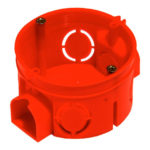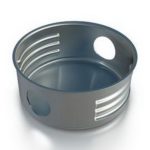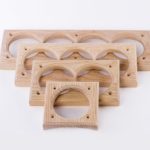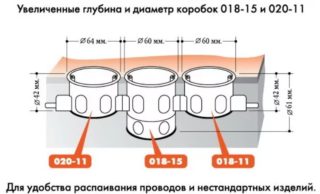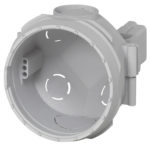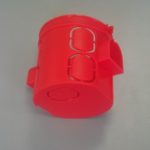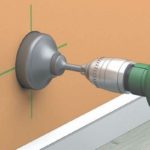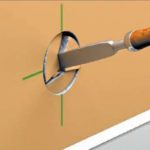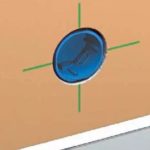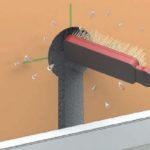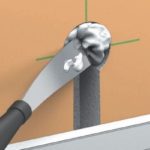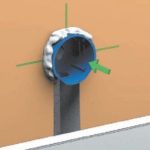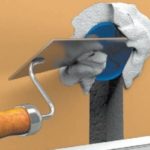Performing electrical work at the facility is not complete without the use of special elements, called socket boxes for concrete, drywall, brick. The installation box is selected according to the type of construction, depth and diameter.
- Is it allowed to conduct an electrician without socket outlets
- Definition of a socket
- Types and types of products
- Material
- Form and construction
- Dimensions (edit)
- Famous manufacturers
- Installation of socket boxes
- The socket box jumped out of the wall
- Mounting the socket strip
- Choosing the right socket for concrete walls
Is it allowed to conduct an electrician without socket outlets
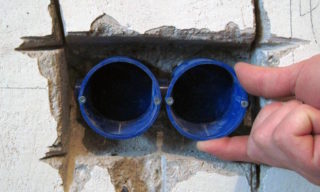
The main purpose of the installation box is to securely fix the socket and cable in the wall. They can loosen if they are simply embedded in the concrete mix without a socket. The plug of any electrical appliance fits tightly into the receptacles on the power point. When it is turned off backwards, you have to apply force, simply pull. If there is no socket in the wall, over time, the hidden wiring will simply fall out of the wall into the hands of the user. This is fraught with dangerous emergencies.
The overhead (external) element is of particular importance when installing wiring on wooden walls. Here, without an installation box, it will not be possible to fix the power point.
Definition of a socket
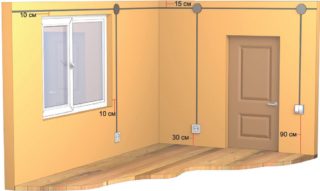
The installation box is one of the main wiring elements on site. The final reliability, the strength of the outlet, as well as the comfort of using the power point for the user depends on the correct installation.
The main technical requirements for the installation of the glass:
- the recommended mounting height of the installation box is from 30 to 90 cm from the floor;
- from the edge of door frames and window openings, you need to retreat at least 10 cm;
- three-phase sockets for powerful equipment at food industry facilities are placed at the bottom of the wall 20 cm from the floor;
- the supply points are removed from the gas pipeline by at least 40 cm;
- in rooms with a high level of humidity, sockets are not installed, they are taken out the door or removed as far as possible from the bath, shower, sink.
Before carrying out electrical work, it is worth de-energizing the facility.
Types and types of products
For socket boxes in concrete, a classification is typical according to several parameters - material, shape, design, dimensions. Sometimes craftsmen choose an element by shade and design. The last two criteria do not affect the functionality of the installation box.
Material
All electrical elements are divided into three types:
- Plastic. Most often, a non-combustible polymer is used for their production. The plastic socket has all the technical connectors for convenient fixing of the socket in the wall. The plasterboard installation box is additionally equipped with special feet.
- Metallic. This is an outdated version of the socket boxes. Today they hardly appear on sale. But if the master has one of these lying around, it can be used no less effectively.
- Wooden shields-gaskets. These are more likely not installation boxes, but just a piece of a strip, on which the socket is then fixed.
Polymer socket boxes have the maximum number of variations in design, color, size.
Form and construction
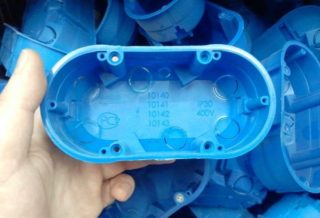
According to the geometric shape, such socket boxes are distinguished:
- Round. The most common.
- Oval. Suitable for mounting a double socket for concrete.
- Square. Have a maximum capacity.
- Composite.With their help, you can easily mount triple socket-outlets for concrete or on a larger number of power points. They are also called block.
- Overhead. These outer glasses are often square, less often round. They are used for laying wiring on wooden walls.
There are also separate types of glasses for installing sockets for the Internet, telephone, cable TV, etc.
Dimensions (edit)
- Diameter. Marked with the letter "D". The most common indicators are 60, 64 and 65, 68, 70, 75 mm.
- Glass depth. Marked with the letter "N". Here the dimensions vary from 25 to 62 mm. The deepest socket has a parameter of 80 mm.
All installation boxes are characterized by a center distance of 71 mm.
Famous manufacturers
Almost all installation boxes are manufactured in accordance with GOST and have similar parameters. For the master, it is often not important whose products to buy. Nevertheless, Russian consumers prefer to use mounting cups from such manufacturers:
- Hegel. The products of this brand appeared on the market in 2006. Electrical installation elements are made in Russia from high quality raw materials purchased from foreign partners.
- Legrand. A French company that manufactures a quality product. The cost of the retail boxes of this brand is much higher than the price of domestic products.
If the master does not want to overpay for the adjusting glass, you can confidently buy products made in Russia or the CIS countries. The shape, dimensions and quality of the product remain the same. In this case, the mark-up for foreign goods is formed taking into account the brand.
Installation of socket boxes
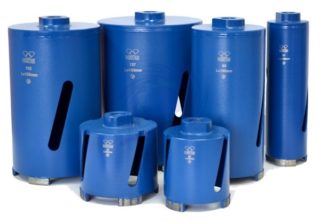
The installation of the glass can be done by hand. To do this, you need to prepare the following tool:
- puncher, chisel and hammer;
- diamond core bit for concrete;
- tape measure, construction marker;
- level;
- gypsum or asbestos for the preparation of the fixing solution;
- putty knife;
- container for the preparation of a construction mixture.
Stages of work:
- Future grooves are marked from the junction box. The lines must be strictly vertical or horizontal.
- The end point of the markup is the intended place of the glass installation. It is drawn with a circle with a diameter of 70 mm.
- Channels are made along the lines of the drawn strobes for laying the wiring.
- A round hole is drilled at the place of the proposed installation of the socket. Its depth is adjusted according to the parameters of the socket. He should completely enter the wall, but not drown much in it. More often, 5-6 cm is enough. The evenness of the depth is controlled by the building level, applying a socket to the socket. Its edges should be completely aligned with the plane of the wall.
- The finished excavation is cleaned of construction dust.
- The wiring laid through the channels is led to the socket. The braid is cleaned and inserted into the slots of the cup holder.
- It is necessary to thoroughly moisten the recess in the wall and coat it with mortar. If this is a gypsum mixture, then it is prepared from powder and water in a 1: 2 ratio. If it is alabaster, then the proportions of powder and water are 4: 1, respectively.
- The finished solution is also treated with a glass from the outside. Then they insert it into the socket, controlling the protrusions above the level of the wall plane. They shouldn't be. An exception is allowed if the panel will be additionally clad with any decorative material. Then the edges of the glass are left protruding by the approximate thickness of the finish (taking into account the glue, plaster layer, etc.).
- After the solution has dried, you can proceed with the installation of the outlet itself.
When the wiring is brought out to the glass sockets, a good supply of cable is left (5-6 cm).
The socket box jumped out of the wall
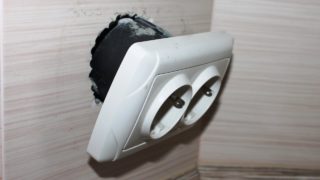
It happens that the installation cup falls out of the panel. This happens for the following reasons:
- Old wiring structure and long-term repairs. It is likely that the fixing solution has simply spilled under the wallpaper or other trim.
- Incorrectly taken proportions of water and powder for preparing a construction mixture. In this case, she does not hold the glass firmly enough.
To fix the situation, you need to assess the scale of the problem. If the socket under the socket is deformed strongly, it is shifted to the side and a new one is made. The old hole is covered with plaster. The installation of a new order book is performed according to the above algorithm.
If we are talking about an improperly prepared solution, it is completely removed from the nest. Prepare a new mixture and install a socket.
Mounting the socket strip
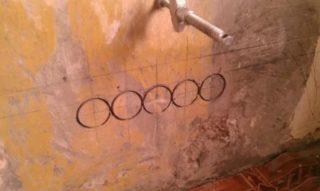
When installing multiple outlets, you can use a special block-type glass according to the number of proposed power points. To do this, several holes are made in the wall using a diamond bit, located side by side. The center distance between them should be 71 mm.
It is important to maintain the horizontal position of the future block. Further, with the help of a hammer and a chisel, remove the excess so that the glass is completely in the nest.
To connect the wires to each outlet, use special jumpers-adapter ears.
The installation of the box is performed in the same way as a glass for a single feed point.
Choosing the right socket for concrete walls
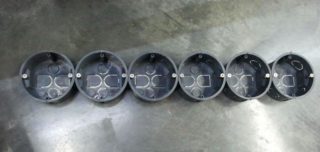
If the master does not know which socket is better for a concrete wall, it is worth considering the following criteria:
- Glass wall thickness. The larger it is, the stronger the product. In addition, although the manufacturers assure that the polymer of the socket is fireproof, it will begin to melt in the event of a strong fire. And the faster, the thinner its walls are.
- Product depth. This parameter is especially relevant if the installation of socket outlets is carried out in one wall from both sides (as in old panel houses). Here it is better to buy two products of 25 mm each and join them than to resort to trimming the box, which will differ in depth.
- Construction type (single, double, block). If you need to mount several outlets in a row, you can buy in-line glasses. They just break at the junction. So you can take as many pieces at once as you need.
To install the socket in drywall, you need to take a glass with fixing lugs. It is attached simply by driving it into the socket. The tabs themselves snap into place on the back of the panel.

